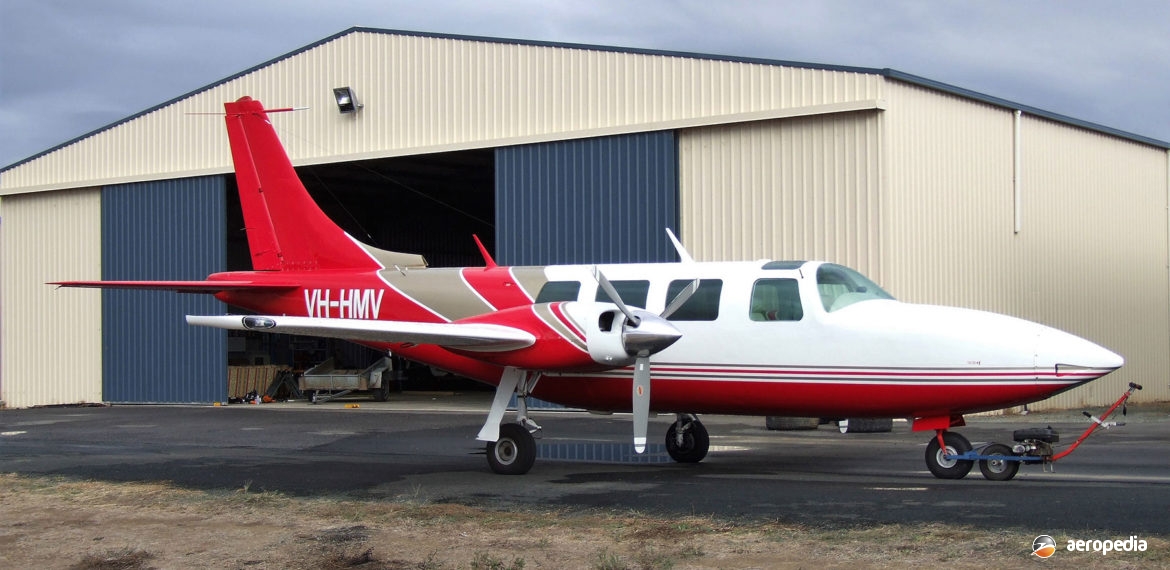Photograph:
Smith Aerostar 600A VH-HMV (c/n 60-0685-7961215) at Echuca, VIC in April 2007 (David C Eyre)
Country of origin:
United States of America
Description:
Light business and executive aircraft
Power Plant:
(601P)
Two 216 kw (290 hp) Lycoming TIO-540-S1A5 six-cylinder horizontally-opposed air-cooled engines
Specifications:
- Wingspan: 11.18 m (36 ft 8 in)
- Length: 10.61 m (34 ft 9¾ in)
- Height: 3.68 m (12 ft 1½ in)
- Wing area: 16.54 m² (178 sq ft)
- Max speed at 7,620 m (25,000 ft): 476 km/h (296 mph)
- Cruising speed at 6,100 m (20,000 ft): 420 km/h (261 mph)
- Stalling speed in landing configuration: 119 km/h (74 mph)
- Initial rate of climb: 600 m/min (1,970 ft/min)
- Single-engine rate of climb: 77 m/min (254 ft/min)
- Take-off run: 579 m (1,900 ft)
- Max operating altitude: 9,144 m (30,000 ft)
- Range at 65% power with 45 mins reserves: 2,285 km (1,420 miles)
- Empty weight: 1,814 kg (4,000 lb)
- Loaded weight: 2,721 kg (6,000 lb)
History:
The Aerostar series of light aircraft was designed by the late Ted Smith, who first became well known in aviation circles in the USA for designing the Aero Commander series of light business twins. Design work began in 1964 and the prototype Aerostar, known as the Model 320, was first flown in November 1966 with 119 kw (160 hp) Lycoming IO-320 engines. Subsequently the Model 360 was flown with 134 kw (180 hp) Lycoming IO-360-E1A engines, and the Model 400 with 149 kw (200 hp) Lycoming IO-360-D1A engines. Eventually the design was developed into the main production aircraft, the Model 600 series, the 600A being powered by 216 kw (290 hp) Lycoming IO-540-K1J5 engines.
The series was originally manufactured by Ted Smith Aircraft Co, a subsidiary of the American Cement Corporation, and production began in 1967. In 1969 the Company’s assets were purchased by Butler Aviation International and, for a period, the type was known as the Butler Aerostar. In 1972 manufacturing rights were re-acquired by Mr Smith’s Aerostar Corporation, and this Company recommenced building the type from then until it was taken over by the Piper Aircraft Corporation in 1978. Production continued in the original Aerostar Corporation premises. A total of 1,010 Aerostars was built, this figure including 519 by Piper, production of the type ceasing in 1984. The Aerostar was marketed as the fastest production twin piston-engine aircraft in the world.
Examples were used for record breaking, these including the 2,000 km (3,218.6 miles) closed circuit speed record of 439.07 km/h (272.83 mph) in August 1975 in a Model 601P; another 601P flown by Philander Claxton III and Jack Cink around the world, a distance of 36,998 km (22,990 miles) in a time of 104 hrs 5 mins; and another, an Aerostar 700 named The Spririt of Kai Tak, being the winning entry in the April 2001 London – Sydney air race.
Basic models produced included the 600 with normally aspirated Lycoming engines, the Model 601 being the same as the 600 except for turbocharged engines; the 601B, a new model introduced in 1979 to replace the 601 having the wingspan extended by 38.1 cm (15 in) on each side, thus increasing the useful load by 122.5 kg (270 lb); the 601P having turbo-supercharged Lycoming TIO-540-S1A5 engines, increased span of the wings and a pressurised cabin; the 602P introduced by Piper in 1981, fitted with low-compression engines with integral turbochargers; the 700 being first flown on 22 November 1972, being slightly larger and having two 261 kw (350 hp) Lycoming TIO-540-U2A engines; and the 700P being a pressurised version. These engines used intercoolers to take the heat out of the induction air, thus providing, it was claimed, better fuel consumption, a maximum speed of 514 km/h (319 mph) being available.
The Model 800 was flown in prototype form in 1979 but did not proceed to production. Further proposed developments included the Superstar 1000 which was intended to have the 325 kw (435 hp) Continental GTSIO-520 engines or 336 kw (450 hp) Lycoming TIGO-541 engines and be able to seat nine. Another variant, the Model 3000, was to have 2,205 lbst Turbomeca Astafan IV engines.
The Aerostar obtained its performance from a sleek, aerodynamically advanced design. The purchase of the design by Piper Aircraft proved to be an efficient way of obtaining a high performance twin to fill a place in the Company’s line-up of aircraft between the Aztec and the Navajo. The type has been very popular in this region, with about 40 examples imported over the years.

